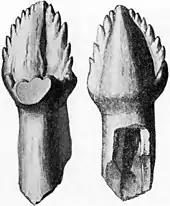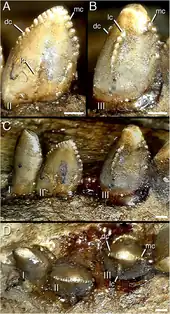Denticle (tooth feature)
Denticles, also called serrations, are small bumps on a tooth that serve to give the tooth a serrated edge. In paleontology, denticle characteristics such as size and density (denticles per unit distance) are used to describe and classify fossilized teeth, especially those of dinosaurs. Denticles are also present on the teeth of varanoid lizards, sharks, and mammals.[1] The term is also used to describe the analogous radular teeth of mollusks.[2][3][4]
 Dromaeosauridae tooth with small denticles along the cutting edge. Scale bars are 1 mm.
Dromaeosauridae tooth with small denticles along the cutting edge. Scale bars are 1 mm. Ankylosaurus tooth with large denticles.
Ankylosaurus tooth with large denticles. Segnosaurus dentition featuring a triple row of denticles.
Segnosaurus dentition featuring a triple row of denticles.
References
- Smith, Joshua B.; Vann, David R.; Dodson, Peter (August 2005). "Dental morphology and variation in theropod dinosaurs: Implications for the taxonomic identification of isolated teeth". The Anatomical Record Part A: Discoveries in Molecular, Cellular, and Evolutionary Biology. 285A (2): 699–736. doi:10.1002/ar.a.20206. PMID 15986487.
- Lowenstam, H.A. (1962). "Magnetite in Denticle Capping in Recent Chitons (Polyplacophora)". GSA Bulletin. 73 (4): 435–438. doi:10.1130/0016-7606(1962)73[435:MIDCIR]2.0.CO;2.
- "Glossary of Terminology and Acronyms /Abbreviations: D". Coral Reef Information System. NOAA. Retrieved 18 October 2022. Archived as PDF.
- Smith, M.R. (2012). "Mouthparts of the Burgess Shale fossils Odontogriphus and Wiwaxia: implications for the ancestral molluscan radula". Proceedings of the Royal Society B. 279 (1745): 4287–4295. doi:10.1098/rspb.2012.1577.
This article is issued from Wikipedia. The text is licensed under Creative Commons - Attribution - Sharealike. Additional terms may apply for the media files.